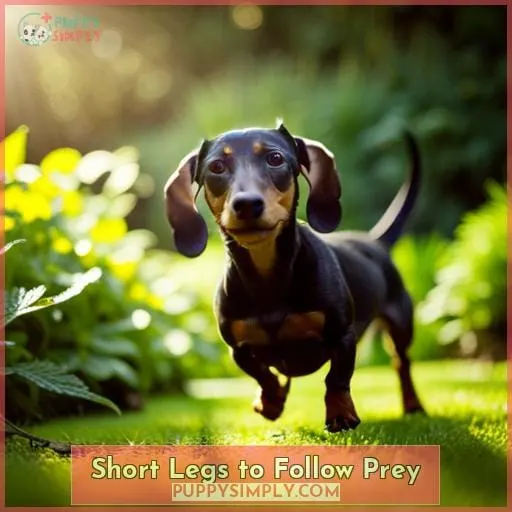This site is supported by our readers. We may earn a commission, at no cost to you, if you purchase through links.
 Imagine the 19th-century hound, snout to tail, a blur of brown and tan muscle, bolting through the German countryside, hot on the trail of a badger.
Imagine the 19th-century hound, snout to tail, a blur of brown and tan muscle, bolting through the German countryside, hot on the trail of a badger.
That’s the dachshund’s legacy: a fierce, independent hunter bred specifically for the task.
Don’t let its compact size fool you. This low-slung breed is a force to be reckoned with, a testament to the power of selective breeding.
Today’s dachshunds may be beloved family pets, but their hunting instincts run deep.
Table Of Contents
- Key Takeaways
- Ancient Hunting Dogs
- Dachshunds for Badger Hunting
- Dachshund Traits for Digging
- Body Built to Go Underground
- Short Legs to Follow Prey
- Dachshund Temperament
- Types of Dachshund Coats
- Dachshund Sizes
- Dachshunds Still Used for Hunting
- Modern Dachshunds as Pets
- Frequently Asked Questions (FAQs)
- Conclusion
Key Takeaways
- Dachshunds were bred by German foresters to hunt badgers and other quarry in tunnels and burrows.
- Their elongated bodies, short legs, sturdy front paws, and loose skin help them dig and maneuver underground.
- Dachshunds use various techniques like sniffing, digging, and squeezing to flush prey from burrows.
- Their independent, stubborn temperaments stem from breeding to boldly hunt badgers underground.
Ancient Hunting Dogs
One of your ancestors used short-legged hunting dogs for going after burrowing animals like badgers back in the Middle Ages.
These early hunting companions had already evolved digging prowess and fearless tenacity ideal for pursuing quarry underground.
Though bred specifically for hunting, they likely offered companionship to the hunters and families they lived amongst.
While these ancient hunting dogs weren’t yet the dachshund breed we know today, they laid critical groundwork for the later emergence of badger-baiting hounds.
Their legacy persists in modern-day dachshunds, no longer used for hunting but still channeling their ancestors’ feisty personalities and talent for burrowing – now mostly applied to backyard escapades rather than badger tunnels.
Though the hunting origins are long past, dachshunds still capture imaginations with their unique bodies and kindred spirits linking back to early companions.
Dachshunds for Badger Hunting
You’re reading about badger-hunting dachshunds because German foresters purposefully bred short-legged dogs to chase quarry underground.
As burrow buddies, dachshunds were bred specifically for badger encounters. Their compact bodies allowed them to fearlessly follow prey into tight burrows.
- Dachshunds have elongated bodies and short legs to fit into burrows.
- Their loose skin protects organs when squeezing into tight spaces.
- Sturdy front paws equipped with claws help them dig efficiently.
As underground hunters, dachshunds needed courage and independence to face badgers alone in dark tunnels.
Despite dangerous confrontations with badgers bearing sharp teeth and claws, dachshunds loyally accompanied their masters on the hunt.
Centuries later, traces of their fiery digging companions’ spirit remain in modern dachshund personalities.
Dachshund Traits for Digging
You’ve equipped your Dachshund with large, paddle-shaped paws and sharp claws to excel at digging prey from underground tunnels.
Their sturdy builds allow them to wiggle and weave through tight burrows with ease.
Dachshunds employ various digging techniques to flush out rabbits, badgers, foxes, and other critters.
Their muscular frames propel them forward as they eagerly explore dark burrows.
With a keen sense of smell guiding them underground, Dachshunds fearlessly navigate soil and tunnel after elusive prey.
Digging Techniques
| Technique | Use |
|---|---|
| Scraping | Loosening soil |
| Paddling | Scooping soil |
| Scratching | Unearthing prey |
Though bred for hunting and tunneling, Dachshunds make delightful household companions today.
Their affectionate natures and compact sizes endear them to many families.
The miniature longhaired Dachshund’s silky coat and the wirehaired’s wiry fur suit them to being loving lapdogs as much as tenacious hunters.
Modern Dachshunds retain their energetic, adventuresome spirits passed down from their badger-baiting forebears.
Body Built to Go Underground
As the badger-hunting hounds follow their quarry underground, their distinctive body shape allows them to navigate the burrows with agility.
Though short in stature, dachshunds possess adaptations facilitating their subterranean exploits. Their long and low silhouette, with a prominent breastbone and well-developed ribcage, permits effortless maneuverability through narrow passages as they track their prey.
Despite tunneling challenges that would deter most canines, these tenacious badger hunters leverage unique techniques attuned over centuries of targeting burrowing animals. An elongated body and short, sturdy legs empower dachshunds to pursue prey into the farthest underground reaches.
So while their adorable appearance captures hearts above ground, few creatures below can evade their relentless excavations in cramped confines.
With a build facilitating their timeless vocation, dachshunds remain consummate hunting hounds perfectly designed to vanish into the depths after burrowing game.
Short Legs to Follow Prey
When hunting underground, you’d need short legs to maneuver through tunnels and continue chasing quarry into narrow passages.
Dachshunds were bred with a low profile to adeptly:
- Track prey scent through winding burrows.
- Navigate tight spaces while maintaining pursuit.
- Sturdily advance despite confined quarters for badger encounters.
Their compact legs enabled them to keep pace with quick prey turning corners in burrows.
Having a low center of gravity from their deep chests aided rapid changes of direction chasing rodents down twisting passageways.
Built for the confined spaces of underground hunting, dachshunds’ short yet muscular legs provided agility without sacrificing heartiness to intrepidly follow prey despite tight quarters likely to be found with badger dens.
Their steady gait and tenacity traversing the undulating tunnels of quarry burrows made these dogs well-equipped partners for extracting the wily, sharp-toothed inhabitants within.
Dachshund Temperament
Dachshunds are independent, stubborn dogs that were bred to fearlessly hunt badgers in underground dens.
Their courageous nature and strong will mean they can be challenging to train, but with plenty of positive reinforcement and persistence, these clever hounds can master basic obedience.
Dachshund owners should be prepared for a mischievous companion that follows its own nose.
Independent
Dachshunds exhibit stubborn independence and a determination to follow their noses.
Their single-mindedness makes training challenging, as they frequently disregard commands in pursuit of intriguing scents.
Celebrity dachshunds like Picasso’s Lump graced avant-garde salons.
Yet their mischievous moments, like Obie the obese dachshund, show why positive reinforcement builds better bonds with these badger-hunting hounds from Germany.
Known for low, sturdy bodies and big personalities shaped by their independent spirits.
Courageous
Dachshunds are courageous to the point of rashness.
You’d admire their fearless nature when facing badgers head-on despite their small size.
These brave little canines possess bravery traits that make them incredible companions.
With bold personalities and a fearlessness that knows no bounds, dachshunds are always ready to protect and defend their loved ones.
Their unwavering courage makes them fearless companions in any situation.
Whether they’re chasing prey or standing up against threats, these sausage dogs showcase the true meaning of being courageous with every step they take on their short but sturdy curved legs.
Types of Dachshund Coats
As an independent and courageous hound, you cherish having choices when it comes to your dachshund’s coat.
You can opt for the short, smooth coat that lets your digits glide swiftly over their supple hide as you bond. Or you may fancy the silky caress of flowing longhair against your skin as you cuddle. Perhaps you crave a wiry-haired wonder whose coarse yet alluring bristles invite frequent gentle strokes.
Each coat type presents grooming challenges to keep their locks lustrous. In cooler climes, a longhaired coat insulates, while smooth and wirehaired varieties better dispel heat.
Follow these coat care tips:
| Coat Type | Brushing Frequency | Bathing Frequency |
|---|---|---|
| Smooth | 1-2 times weekly | Monthly |
| Longhair | Daily | Every 2 weeks |
| Wirehair | 2-3 times weekly | As needed |
Stay tuned to learn about the different sizes of dachshunds still used for hunting today, yet equally endearing as modern pets.
Dachshund Sizes
Although you’re likely familiar with the classic wiener dog proportions, dachshunds actually come in three different size varieties if you look closely.
Standard dachshunds are the original badger hunting dogs, with heights from 8 to 9 inches and weights from 16 to 32 pounds.
Miniature dachshunds were developed more recently and stand 5 to 6 inches tall, weighing less than 11 pounds.
Tweenies fall in between at 6 to 8 inches tall and 11 to 16 pounds.
While standards retain the best badger hunting abilities, all sizes share the grit, independence, and playfulness the breed is known for.
Whether you live in an apartment or a farm, dachshunds now make faithful companions in small, sturdy packages with personalities as big as their boisterous barks.
Carefully consider each size’s exercise needs and barking volume before bringing one of these compact canines home.
Dachshunds Still Used for Hunting
You’re intrigued some Dachshund owners still use these dogs for hunting badgers and other small game today.
The Dachshund’s hunting instincts are deeply rooted in the breed’s history and origins. Many modern Dachshund breeders prioritize preserving these strong hunting abilities through careful breeding practices.
For those who still hunt with Dachshunds, training can be challenging due to the breed’s independent nature. However, with persistence and positive reinforcement, Dachshunds can excel at flushing or tracking rabbits, foxes, groundhogs, and other burrowing animals.
In areas where badger populations need to be controlled for conservation efforts, Dachshunds may sometimes still be utilized.
Overall, this versatile hound retains its excellent nose, courage, and determination that served it well as a tenacious badger hunter centuries ago.
Modern Dachshunds as Pets
Today, as a house pet, you’re faced with combating your dachshund’s strong will and independent spirit through proper training and socialization.
Establish yourself from the start as the confident leader.
Use positive reinforcement.
Socialize early and often to curb aggression toward strangers.
Though challenging, the rewards of dachshund companionship are great.
Celebrities like Picasso, Warhol, and Monroe have counted dachshunds as their closest confidantes.
But guard against obesity, as their begging eyes make overfeeding tempting.
Historically, anti-German sentiment during World War I led to temporarily renaming dachshunds liberty hounds.
Cherish your dachshund in all its unique glory—whether smooth, wirehaired, or long coated.
For this intrepid hound has the heart of a badger-hunting warrior bundled up in a cuddly, low-slung package.
Frequently Asked Questions (FAQs)
What health issues are common in dachshunds?
Intervertebral disc disease is a major concern because of their long spine and short legs.
Their backs are shaped to burrow but vulnerable to injury, so be cautious about letting them jump onto furniture or from heights.
Weight control is essential for healthy joints and discs.
Facial folds need regular cleaning to prevent infections.
Their floppy ears are also prone to issues requiring frequent checks.
How much exercise does a dachshund need per day?
You should aim to walk your dachshund 20-30 minutes daily.
Their active, working breed needs regular activity.
But limit jumping and be attentive, as their long backs are prone to injury.
Mental stimulation through training is also vital for their lively, inquisitive minds.
What kind of temperament do dachshunds have around children?
You’ll find dachshunds gentle yet fun with kids if socialized young.
Despite their bold hunter roots, they cherish attention from little ones.
Still, supervise play given their long backs and feistiness.
With care, they make lively family companions.
How easy is it to train a dachshund?
Training a dachshund takes patience and persistence.
Their independent nature means they may not respond well to commands at first.
Use positive reinforcement and make training fun.
Reward good behavior.
With time and consistency, you’ll have an obedient dachshund eager to please you.
What is the average lifespan of a dachshund?
You can expect your dachshund to live an average of 12-14 years with proper care and nutrition.
Keep your pup active and at a healthy weight.
Provide routine vet checkups.
Give lots of love to help ensure your sausage dog lives a long, happy life with you.
Conclusion
Don’t let the dachshund’s small size fool you.
Though these dogs may be cuddly couch potatoes today, their fierce hunting spirit still runs deep.
With their sturdy bodies, short legs, and courageous temperament honed over centuries for pursuing badgers underground, dachshunds embody the power of purposeful breeding.
So the next time you gaze into your doxie’s bright eyes, remember the badger-hunting hound within.
















